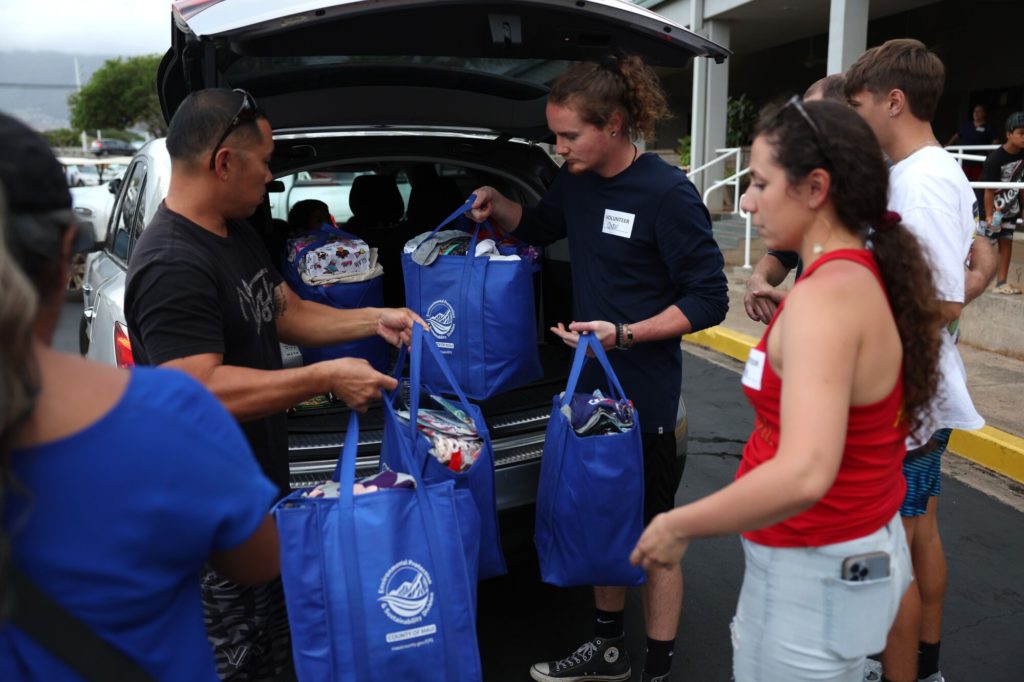Hundreds of people are still missing after wildfires turned the historic Hawaiian town of Lahaina into ash and rubble, as the official death toll rose to 55.
(Bloomberg) — Hundreds of people are still missing after wildfires turned the historic Hawaiian town of Lahaina into ash and rubble, as the official death toll rose to 55.
As firefighters said the blaze was 80% contained, aerial surveys found more than 270 buildings burned in the seaside resort, once the capital of the Hawaiian Kingdom. The police chief said perhaps 1,000 people remain unaccounted for, as thousands of residents and tourists fled an area left without electricity, phone service or the internet.
Hawaii Governor Josh Green, who walked through the devastated town Thursday, called it the largest natural disaster his state had ever faced and warned the death toll would likely rise.
The type of grass fire that hit Lahaina spreads extremely quickly, according to climate and wildfire expert, Mojtaba Sadegh, an associate professor of civil engineering at Boise State University. The blaze was fanned by powerful winds from a high-pressure zone to the north that swept downwards toward Hurricane Dora, a low-pressure zone far off to the south.
Read More: Wildfire Expert on What Fed Deadly Flames in Hawaii: Q&A
While such complexities make it harder for scientists to define the role global warming may have had in exacerbating the disaster, climate change is extending the length of fire season and increasing areas burned in many parts of the world. A recent study Sadegh co-authored found that between 2000 and 2019, the number of people in the US exposed to wildfire risk doubled.
The old Lahaina, including its Front Street packed with waterfront restaurants and shops, has been destroyed, with Green telling reporters it looked like it had been bombed. Virtually every building in Lahaina, he said, would need to be replaced, taking many years and billions of dollars.
His administration, he said, was reaching out to nearby hotels emptied of vacationers to secure 2,000 rooms for the displaced. But he also asked island residents whose homes remained intact to take in people needing shelter.
“All of us have a loved one here on Maui that lost a home, that lost a friend,” Green said.
The fire was one of several that erupted this week on Maui, the second-largest of the Hawaiian islands. Accuweather Inc. put the preliminary estimate of damage from the fires at $8 billion to $10 billion.
While it is unknown what sparked the flames, they drew their destructive power from some of the same conditions that have fueled devastating blazes this year from Canada to Greece: vegetation sucked dry by drought and strong winds. Some 36% of Maui County is in moderate to severe drought, according to the US Drought Monitor.
“This is not too surprising — it’s just surprising that it happened on Maui,” said Craig Clements, director of the Wildfire Interdisciplinary Research Center at San Jose State University in California. The speed of the Lahaina fire, which appears to have started on the eastern edge of town and was rapidly blown westward to the sea, likely led to the high death toll, he said.
Buses scooped up tourists Thursday from the resorts that line the shore north of Lahaina and ferried them directly to the island’s Kahului Airport, where more than 1,400 people spent the night awaiting morning flights. Another 1,300 people slept in shelters, according to the county.
President Biden on Thursday declared a major disaster in Hawaii, freeing up federal funds to aid recovery. “Anyone who has lost a loved one or whose home has been damaged or destroyed is going to get help immediately,” he said at an event in Salt Lake City.
Read More: Biden Vows to Rush Federal Support to Wildfire-Ravaged Hawaii
Crews are working to clear roads and other areas of trees and debris. Emergency responders continued combing the wreckage for survivors or the deceased. Maui Mayor Richard Bissen warned evacuees not to try to return while that work continued, and said the county would do everything possible to identify those killed in the fire, to bring their families closure.
Wildfires used to be rare in Hawaii but they started becoming more frequent in the 1990s as many of the old agricultural plantations and ranches closed, said Clay Trauernicht, a wildfire management specialist at the University of Hawaii at Manoa. Invasive, non-native grasses took over fallow land and have provided new fuel for blazes.
Some communities are trying to reforest these grass lands, using tree shade to control the grasses, or return them to agriculture, but not at the scale needed, he said.
“We’ve just primed ourselves for a disaster like this,” Trauernicht said.
–With assistance from Cailley LaPara, Heesu Lee and Eric Roston.
More stories like this are available on bloomberg.com
©2023 Bloomberg L.P.










